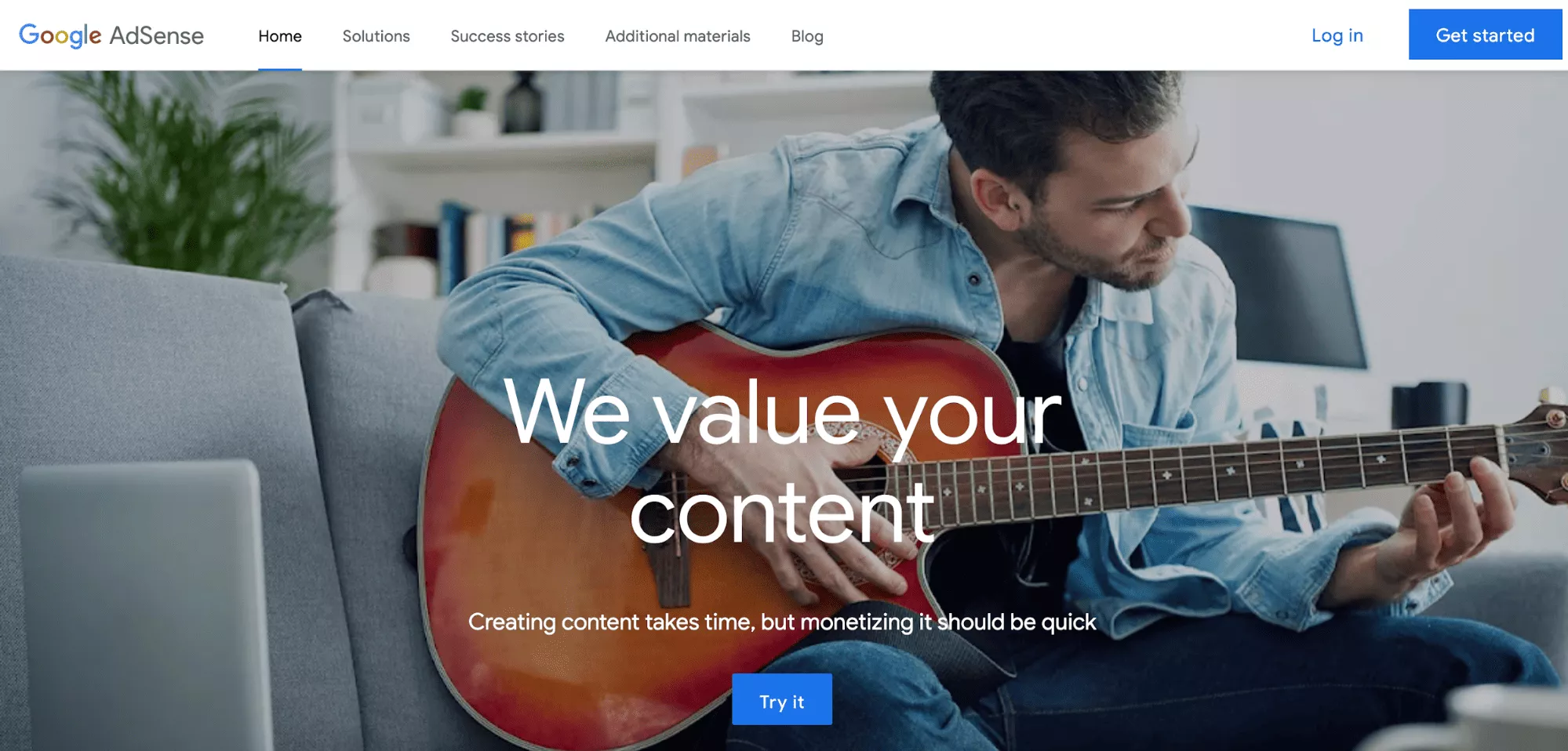How to Get a Google AdX Account: A Step-by-Step Guide
One of the most effective ways to generate revenue from web traffic is to monetize a website through programmatic advertising (automatic purchase of digital ads). Google Ad Exchange (Google AdX) is a very popular tool for this due to its useful features, access to premium advertisers, and enhanced control over inventory.
But how do you get a Google AdX account?
In this step-by-step guide, I’ll walk you through the essentials of Google AdX, including two different ways of accessing Google AdX, the pros and cons of each approach, and real-world case studies.
What is Google Ad Exchange
Google Ad Exchange, often referred to as Google AdX, is a real-time programmatic ad marketplace where premium publishers and advertisers interact. AdX offers publishers advanced monetization opportunities through real-time bidding (RTB), during which multiple advertisers compete to display their ads in front of your audience.
How Does Ad Monetization Work
Here’s how monetization works in Google AdX:
- Inventory Submission. Publishers start by offering their ad space (inventory) for sale.
- Real-Time Bidding (RTB). Advertisers then bid on this inventory in real-time. The highest bid wins, and the ad is displayed.
- Revenue Generation. Each impression generates revenue, with the publisher taking a portion of the winning bid.
AdX is particularly suited for publishers with high traffic and premium content, as it connects them to a network of premium advertisers and yields higher revenue compared to traditional ad networks like Google AdSense.
A premium publisher is a well-respected content provider recognized for producing authoritative, trusted, and engaging media. Such publishers have a large, loyal audience and high content standards.
How Much Can You Earn
Based on my experience, here is a rough estimate of what publishers might earn through Google AdX based on their traffic levels, assuming effective optimization strategies:
|
Monthly Visitors |
Estimated Monthly Revenue, $ |
|
300,000 |
1,500–4,000 |
|
500,000 |
2,000–6,000 |
|
5,000,000 |
20,000–60,000 |
Of course, the actual earnings may differ depending on traffic location, ad placements, content quality, and more.
How Do I Get a Google Ad Exchange Account
Google AdX is an invite-only platform, which makes it more difficult to access than Google AdSense. However, there are two main ways to get an AdX account:
Get an Invitation Directly from Google
One of the most straightforward ways to access Google AdX is to get invited by Google itself. Here’s how you can qualify:
Step 1: Check the requirements
Before you apply for a Google Ad Exchange account, ensure that your website meets Google’s standards:
- High-Quality Content. Your website should have original content that complies with Google’s policies.
- Adequate Traffic. Generally, Google looks for websites with significant traffic to ensure ad revenue potential. In practice, this means sites with at least 500,000 monthly page views or more.
- Compliance with Regulations. Ensure your site complies with regulations like GDPR and CCPA.
Step 2: Set up a Google AdSense account
Google AdSense is a common starting point for publishers. It allows you to earn revenue by displaying ads on your site and is often a prerequisite for Google AdX.
Follow these steps to set up Google AdSense:
- First, sign up by visiting the Google AdSense website and creating an account.

- The next step is to add ad units. Once approved, add ad units to your site and start generating revenue.
- Ensure your site meets the requirements. Maintain compliance with Google’s content policies and build traffic to meet AdX requirements.
Step 3: Get an invite through Google Ad Manager
In order to receive an invitation, you need to have a Google Ad Manager (GAM) account. You may then receive an invitation based on your performance and compliance. If you don’t have one, here are the steps you need to follow:
- Apply for Google Ad Manager. Create a GAM account and set up your ad units and campaigns.
- Optimize your ads. Implement best practices to increase ad revenue and attract Google’s attention.
- Wait for an invite. If you meet the requirements, you could receive an invitation to Google Ad Exchange, which could take anywhere from a few days to a few weeks.
Work with a Google AdX Reseller or Certified Partner
If you don’t meet the traffic criteria to get your own AdX account, you can work with a Google AdX reseller or Google Certified Publishing Partner (GCPP). These partners provide access to AdX through Google’s Multiple Customer Management (MCM) feature, which allows a “parent” account to manage advertising for “child” accounts.
Step 1: Identify a reseller or partner
Start by researching different GCPPs or AdX resellers. Look for reputable companies with a strong track record in managing Google AdX accounts and supporting publishers.
AdX resellers are not officially listed, and each promotes themselves independently. This means that the only structured search is available on the Google Certified Publishing Partners page, but beyond that, it’s an open market.
Consider their experience, client base, and reputation within the industry. Resellers typically offer better revenue share rates, making them an attractive option for smaller or midsized publishers. In comparison, GCPPs provide a comprehensive service that includes full setup, ongoing optimization, and compliance management.
Step 2: Evaluate their services
Once you’ve identified potential partners, evaluate their service offerings. Consider the following:
- Range of Services. Determine if the Partner or Reseller offers a full suite of services, including ad setup, optimization, and reporting.
- Pricing Structure. Understand how they charge for their services. It could be a revenue share, flat fee, or performance-based model.
- Customer Testimonials. Read reviews and testimonials to gauge client satisfaction and the reseller’s credibility.
Step 3: Sign an agreement
After choosing a partner, you’ll need to sign an agreement outlining the terms of your partnership.
Once you sign the agreement, your partner will send you an invitation to join their AdX account as a “child” under their MCM setup. This invitation allows you to access Google AdX and leverage the partner’s expertise in managing advertising campaigns.
The partner will handle most administrative tasks, ad campaign management, and compliance, providing you with a simplified pathway to monetize your website through Google Ad Exchange.
If you’re not eligible for a direct AdX account, consider partnering with a Google AdX reseller or certified partner. It offers a gateway to the advantages of programmatic advertising while simplifying the complexities of account management.
Ultimately, deciding whether to manage your own AdX account or work with a partner involves weighing the pros and cons of each approach, which I’ll explore in the next section.
The Pros and Cons of Managing Your Own AdX Account
|
Pros |
Cons |
|
Full Control. Enjoy complete control over ad placement, pricing, and management. |
Administrative Overhead. It takes time and expertise to manage the account. |
|
Direct Relationship with Google. Manage your Google AdX account directly without intermediaries. |
Compliance Responsibility. You are responsible for adhering to Google’s policies and regulations. |
|
Customizable Campaigns. You can customize ad campaigns and targeting to maximize revenue. |
Learning Curve. Understanding and optimizing Google AdX can be complex. |
The Pros and Cons of Working with a Partner
|
Pros |
Cons |
|
Reduced Overhead. The partner will handle the administrative tasks, reducing your burden. |
Less Control. You give up some control over ad campaigns when working with a partner. |
|
Expertise. Partners are experienced in managing AdX accounts and can optimize your campaigns. |
Revenue Sharing. You may need to share a portion of your revenue with the partner. |
|
Support and Resources. Gain access to additional resources and support through the partner. |
Dependence on the Partner. Your success depends on the partner’s performance and stability. |
Discover how Google App Campaign Management Services can help your mobile app reach high-intent audiences across Google's ecosystem.
Successful Partnerships with Netpeak Agencies Group: Real-World Cases
As a certified Google AdX partner, Netpeak Agencies Group has helped publishers of various sizes increase their ad revenue through optimized access to premium programmatic advertising. Below, you can find two case studies that demonstrate the potential value to be gained by such collaboration.
Case Study 1. A Publisher with 300,000 Monthly Visitors
A small cooking blog with 300,000 monthly visitors partnered with Netpeak Agencies Group to gain access to Google AdX.
By leveraging Netpeak’s advanced optimization strategies, the publisher increased their average CPM by 20%, resulting in an estimated monthly revenue of $2,500. This was a significant increase from $1,500 using only AdSense.
Key Optimizations:
- Enhanced bid competition using dynamic floor prices.
- Improved ad placements and formats for better viewability.
Case Study 2. A Publisher with 5,000,000 Monthly Visitors
A large online news portal with 5,000,000 monthly visitors wanted to transition from Google AdSense to AdX for higher revenue potential.
Netpeak Agencies Group provided seamless integration with Google AdX and optimized the ad operations. Thanks to improved demand from premium advertisers, the publisher’s monthly revenue jumped from $15,000 to $35,000.
Key Optimizations:
- Custom header bidding setup.
- Personalized ad placement and layout testing to increase user engagement without sacrificing site experience.
- Direct ad campaign optimization.
Thanks to our specialists’ guidance, the client successfully achieved their revenue goals while maintaining a positive user experience.
These examples demonstrate the value of working with Netpeak Agencies Group. We offer personalized support and expertise to help publishers maximize their ad revenue, whether through Google AdX, Header Bidding, direct ad campaigns, or other advertising strategies.
Conclusion
Google Ad Exchange is a premium ad marketplace connecting publishers with high-quality advertisers through real-time bidding.
It is ideal for publishers with large traffic volumes and premium content, as AdX offers enhanced revenue opportunities compared to Google AdSense. Publishers with high traffic can even double their revenue by transitioning from AdSense to AdXs.
There are two ways of getting a Google AdX account.
- Direct invitation from Google:
- High traffic is needed (usually 500,000+ monthly views).
- Publishers need to meet Google’s strict standards.
- A Google AdSense account is required as a starting point, followed by the potential to receive an invite through Google Ad Manager.
- Partnering with a Google AdX Reseller or Certified Partner (GCPP):
- This option is ideal for smaller publishers who don’t meet the traffic criteria for a direct AdX account.
- Resellers might offer better revenue shares, while GCPPs provide complete setup, ongoing management, and compliance support.
Whichever method you choose, keep in mind that each has its own pros and cons.
- Managing your own AdX account:
- Full control over ad placement, pricing, and custom campaigns.
- Direct relationship with Google, enabling personalized settings.
- Requires advanced expertise and responsibility for compliance.
- Partnering with a Google AdX Reseller or GCPP:
- Reduced administrative burden, as the partner handles setup and ongoing optimization.
- Access to expert knowledge and premium advertisers.
- Revenue sharing reduces your profit, and you lose some control over campaigns.
Related Articles
Display Advertising Effectiveness Analysis: A Comprehensive Approach to Measuring Its Impact
In this article, I will explain why you shouldn’t underestimate display advertising and how to analyze its impact using Google Analytics 4
Generative Engine Optimization: What Businesses Get From Ranking in SearchGPT
Companies that master SearchGPT SEO and generative engine optimization will capture high-intent traffic from users seeking direct, authoritative answers
From Generic to Iconic: 100 Statistics on Amazon Marketing for Fashion Brands
While traditional fashion retailers were still figuring out e-commerce, one company quietly revolutionized how U.S. consumers shop for everything from workout gear to wedding dresses



